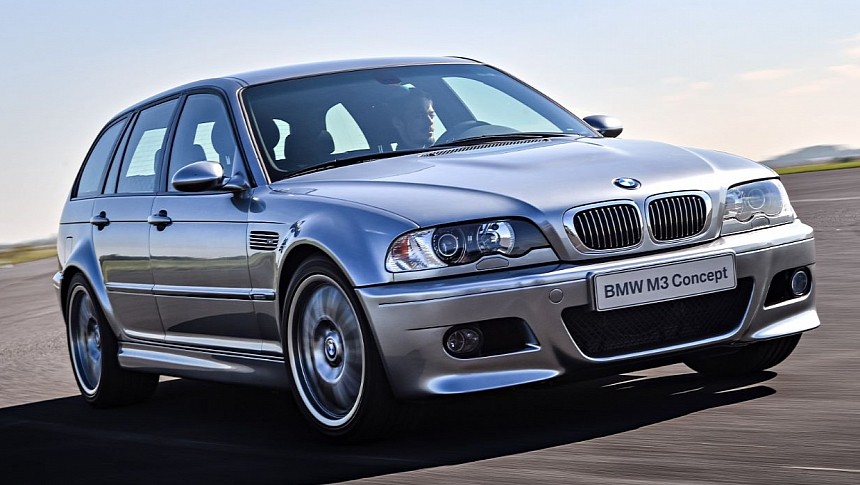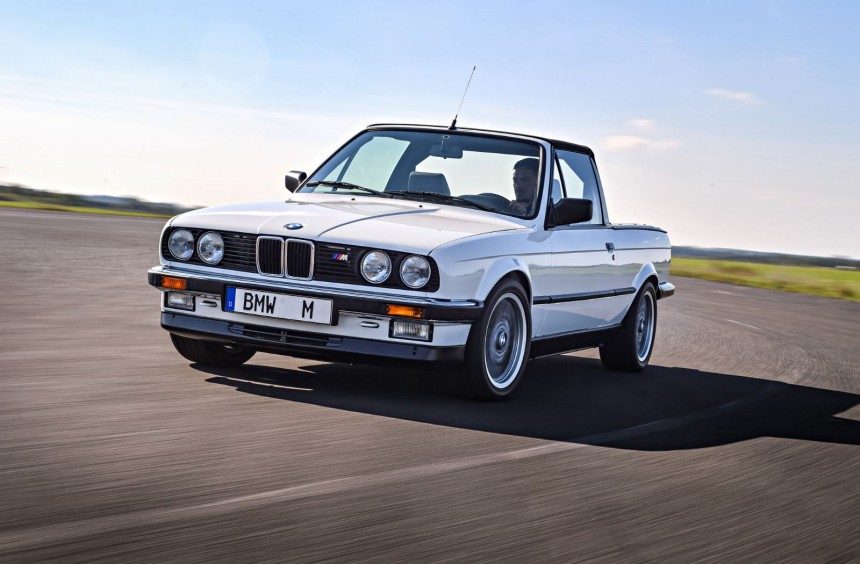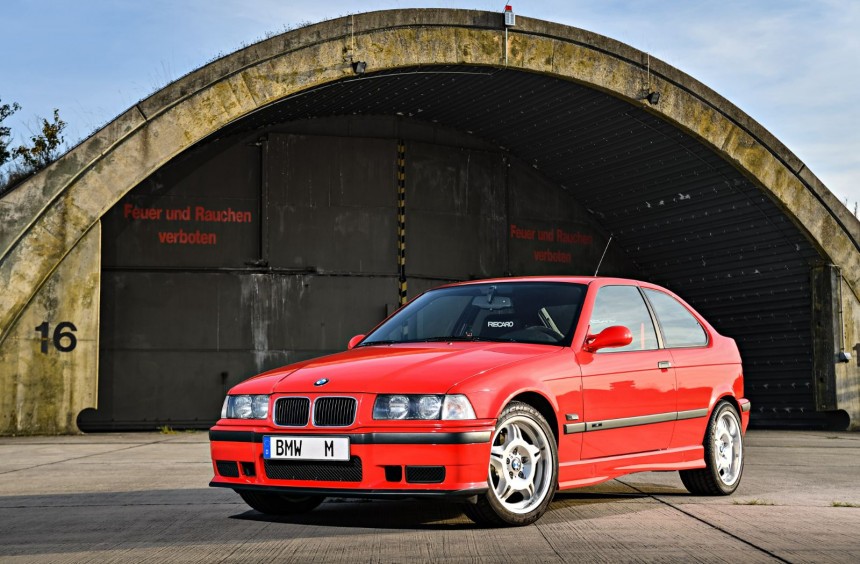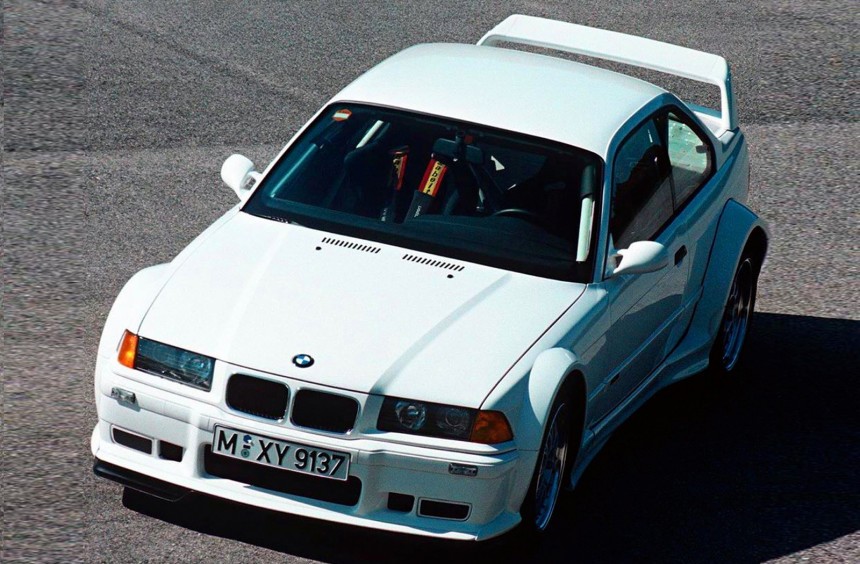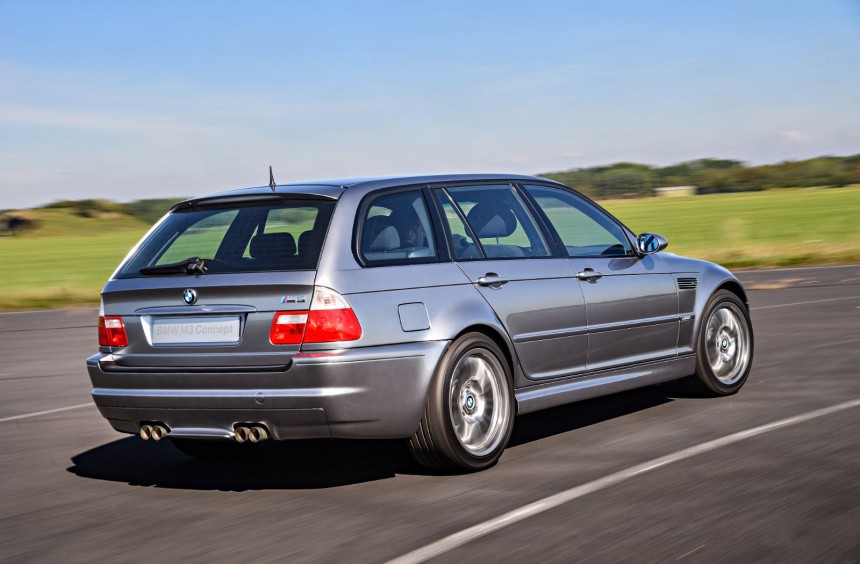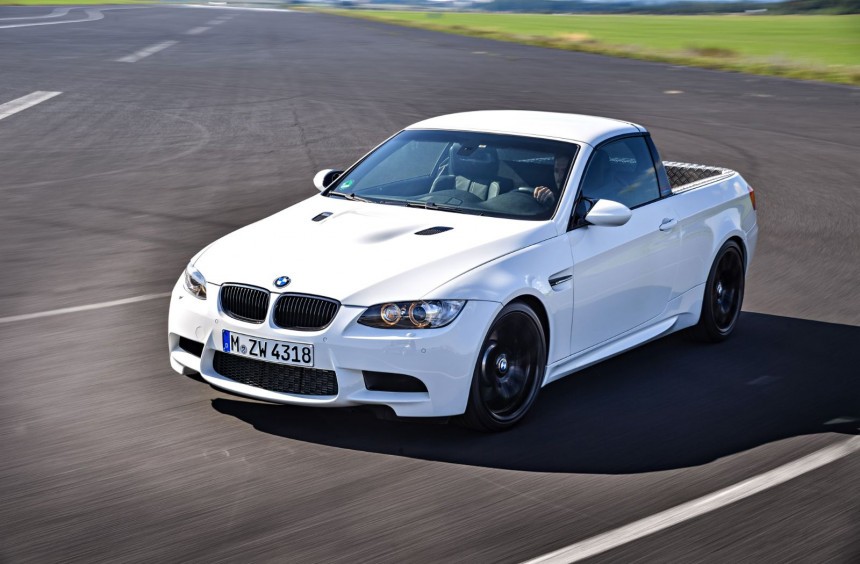Throughout the lifetime of its most popular high-performance model, BMW developed some experimental one-offs that never made it into production.
The BMW M story began in May 1972 when only 35 of the company's most talented designers and engineers were tasked with bolstering the manufacturer's image through motorsport (hence the M).
The division's first project was transforming the plebian E9 coupe into a thoroughbred race car that could compete in the European Touring Car Championship. Since homologation rules required manufacturers to build a minimum number of street-legal units, the 3.0 CSL was born.
Highly successful as a race car and road-legal homologation special, the compact 3.0 CSL paved the way for what would become BMW M's most popular model.
But the M3, first introduced at the 1985 Frankfurt Motor Show, was not the first M-badged model. That distinction goes to the mid-engine M1 unleashed on public roads in 1978.
During its five-decade-long history, BMW M produced many iconic race cars and street-legal beasts based on various models, but unquestionably the most famous is still the 3 Series-based M3.
Besides the famous race cars and production versions that made it to the track or dealership floor, BMW M also developed a series of exciting one-offs that deserve to be remembered.
The first M3 was born during the mid-1980s as BMW M wanted to dominate the German touring car championship better known as DTM (Deutsche Tourenwagen Meisterschaft).
As with the 3.0 CSL, the German carmaker had to build a series of road-legal versions, so the M division took the two-door E30 sedan and transformed it into a high-performance banger that sold like hotcakes.
Apart from the conventional two-door sedan, the E30 M3, BMW M built a convertible version that made it into production in 1988. But they didn't stop there and decided to also devise a pickup version.
Unlike the convertible, the pickup was never meant to make it into production. Instead, it was a side project meant to help students, graduate trainees, and apprentices to hone their skills.
This wacky M3 was based on a 3-Series convertible chassis that was already reinforced in all the right areas on the assembly line. The rear portion of the body was modified, then a bed was created.
Finished in 1986, two years before the M3 convertible was introduced, the pickup featured the same S14 performance engines and a unique suspension setup.
The BMW M team used it to haul parts and work equipment in style for over 25 years. It was retired in 2012, receiving a place in the BMW M museum after an extensive restoration.
After the resounding success of the first M3, BMW M launched an improved successor in 1992. Based on the newer E36 3 Series, the M3 morphed from a homologation special into a more-refined, upscale high-performance car.
It was powered by a larger, more powerful inline-six, had a luxurious interior, and, in addition to the returning two-door coupe and convertible versions, it was available as a four-door sedan.
The carmaker also considered launching a hatchback version meant for the younger generation and built a crazy prototype.
Based on the Kompact 3-Series Compact (arguably the ugliest BMW of all time), the prototype was powered by the M3's 321-hp S50B32 inline-six and also received a set of upgrades including M3 bumpers, skirts, wheels, interior trims, and unique Recaro fixed bucket seats.
The M crew made it 330 pounds (150 kg) lighter than the M3 coupe, which reportedly resulted in faster acceleration and better handling.
Multiple German publications were allowed to test the M3 Compact, and the reviews were encouraging. But, BMW's marketing team concluded that the hatchback would sell poorly, so production plans were scrapped.
Nevertheless, as the M3 grew larger with future generations, the concept of a smaller M model was successfully employed with the M1 and M2 versions.
The E30-based model was the first and last M3 homologation specifically built for motorsport dominance. But, that doesn't mean the E36 and E46 versions didn't become race cars.
For the E30's success, BMW M planned a campaign in the newly-formed German ADAC GT Cup, but the new M3 in its stock form didn't quite fit the bill.
Therefore, the division went ahead and transformed it into a thoroughbred race car, but to gain homologation, they also had to build a single road-going example.
On the outside, the car christened M3 GTR Strassenversion (street version) received a thoroughly redesigned body kit and a large rear wing, while inside, everything deemed unnecessary, like sound insulation or the backseat, was stripped out.
Under the hood, the GTR featured a bored-out version of the stock S50B30 naturally-aspirated DOHC 24-valve inline-six that could make around 350 hp.
While the race cars enjoyed some success in various competitions, this fantastic one-off is unaccounted for.. Since the Bavarians haven't showcased it in over 30 years, many assume it was either dismantled or converted into a race car. Some sources state that it's in the possession of the Quandt family, who prevented BMW from going bankrupt in the early 1960s and still owns a share of the company today.
A similar formula was employed for the E46 M3, but this time, it resulted in six amazing Strassenversions. Powered by a race-bred V8, the E46 M3 GTR is far more popular today, mainly thanks to its role in the original Need for Speed: Most Wanted video game.
For the third, E46 3 Series-based generation, the M3 reverted to only two available body styles: coupe and convertible.
While the four-door was dropped since BMW figured that buyers who wanted an M sedan went for the larger M5, they decided to experiment with an M3 wagon that could compete with Audi's newly-introduced RS4 Avant quattro.
In 2000, they put together a secret prototype that shared all the exterior upgrades of the coupe and convertible M3s, like bumpers, wider front fenders with built-in grilles, bulged hood, side mirrors, and wheels. They even modified the rear doors and quarter panels to bolster the wheel arches and give it a more aggressive look.
Of course, the prototype also borrowed the 343-hp S54 straight-six and five-speed manual from its two-door siblings, meaning it could sprint to 60 mph (97 kph) from a standstill in around 5.3 seconds.
Compared to the E36 M3 Compact, the E46 M3 wagon was an absolute beauty, and I, for one, still can't forgive BMW for not greenlighting its production.
Thankfully, the decision-makers changed their mind twenty years later, and the current M3 is available as a wagon.
After two spectacular generations powered by six-cylinder engines, the fourth iteration of the M3 received a powerful V8.
Codenamed S65, it initially displaced 4.0 liters and made 414 hp, but the 2010 GTS and 2011 CRT special editions received an enlarged 444hp, 4.4-liter version of the engine.
Like previous generations, the E9x M3 was available as a two-door coupe (E92) and convertible (E93) - albeit the latter was the first M3 to feature a retractable hardtop. Furthermore, the four-door sedan body (E90) returned, marking the second time an M3 could be had with more than two doors.
On April Fool's Day in 2011, BMW M announced that it would kick off production of a pickup variant. Though the last part was a joke, the car was very real.
Like its E30 M3 pickup predecessor, it was based on a convertible, but this time an E93 M3 was used as the donor car instead of a standard drop-top 3 Series. That meant the pickup retained all the exterior styling cues of its production siblings, including the widened fenders and quarter panels.
Unlike the previous M3 pickup created on an E30 convertible chassis that had to be modified and equipped with M3 hardware, work on the new one was more straightforward. A bed had to be built from scratch, but the tailgate and removable roof were fabricated from existing components, while the powertrain was untouched.
The E93 M3 pickup took over hauling duties from the venerable E30 M3 pickup, and it's still being used by the Bavarian motorsport division today.
The division's first project was transforming the plebian E9 coupe into a thoroughbred race car that could compete in the European Touring Car Championship. Since homologation rules required manufacturers to build a minimum number of street-legal units, the 3.0 CSL was born.
Highly successful as a race car and road-legal homologation special, the compact 3.0 CSL paved the way for what would become BMW M's most popular model.
But the M3, first introduced at the 1985 Frankfurt Motor Show, was not the first M-badged model. That distinction goes to the mid-engine M1 unleashed on public roads in 1978.
During its five-decade-long history, BMW M produced many iconic race cars and street-legal beasts based on various models, but unquestionably the most famous is still the 3 Series-based M3.
Besides the famous race cars and production versions that made it to the track or dealership floor, BMW M also developed a series of exciting one-offs that deserve to be remembered.
BMW E30 M3 Pickup
As with the 3.0 CSL, the German carmaker had to build a series of road-legal versions, so the M division took the two-door E30 sedan and transformed it into a high-performance banger that sold like hotcakes.
Apart from the conventional two-door sedan, the E30 M3, BMW M built a convertible version that made it into production in 1988. But they didn't stop there and decided to also devise a pickup version.
Unlike the convertible, the pickup was never meant to make it into production. Instead, it was a side project meant to help students, graduate trainees, and apprentices to hone their skills.
This wacky M3 was based on a 3-Series convertible chassis that was already reinforced in all the right areas on the assembly line. The rear portion of the body was modified, then a bed was created.
Finished in 1986, two years before the M3 convertible was introduced, the pickup featured the same S14 performance engines and a unique suspension setup.
The BMW M team used it to haul parts and work equipment in style for over 25 years. It was retired in 2012, receiving a place in the BMW M museum after an extensive restoration.
BMW E36 M3 Compact
It was powered by a larger, more powerful inline-six, had a luxurious interior, and, in addition to the returning two-door coupe and convertible versions, it was available as a four-door sedan.
The carmaker also considered launching a hatchback version meant for the younger generation and built a crazy prototype.
Based on the Kompact 3-Series Compact (arguably the ugliest BMW of all time), the prototype was powered by the M3's 321-hp S50B32 inline-six and also received a set of upgrades including M3 bumpers, skirts, wheels, interior trims, and unique Recaro fixed bucket seats.
The M crew made it 330 pounds (150 kg) lighter than the M3 coupe, which reportedly resulted in faster acceleration and better handling.
Multiple German publications were allowed to test the M3 Compact, and the reviews were encouraging. But, BMW's marketing team concluded that the hatchback would sell poorly, so production plans were scrapped.
Nevertheless, as the M3 grew larger with future generations, the concept of a smaller M model was successfully employed with the M1 and M2 versions.
BMW E36 M3 GTR Strassenversion
For the E30's success, BMW M planned a campaign in the newly-formed German ADAC GT Cup, but the new M3 in its stock form didn't quite fit the bill.
Therefore, the division went ahead and transformed it into a thoroughbred race car, but to gain homologation, they also had to build a single road-going example.
On the outside, the car christened M3 GTR Strassenversion (street version) received a thoroughly redesigned body kit and a large rear wing, while inside, everything deemed unnecessary, like sound insulation or the backseat, was stripped out.
Under the hood, the GTR featured a bored-out version of the stock S50B30 naturally-aspirated DOHC 24-valve inline-six that could make around 350 hp.
While the race cars enjoyed some success in various competitions, this fantastic one-off is unaccounted for.. Since the Bavarians haven't showcased it in over 30 years, many assume it was either dismantled or converted into a race car. Some sources state that it's in the possession of the Quandt family, who prevented BMW from going bankrupt in the early 1960s and still owns a share of the company today.
A similar formula was employed for the E46 M3, but this time, it resulted in six amazing Strassenversions. Powered by a race-bred V8, the E46 M3 GTR is far more popular today, mainly thanks to its role in the original Need for Speed: Most Wanted video game.
BMW E46 M3 Wagon
While the four-door was dropped since BMW figured that buyers who wanted an M sedan went for the larger M5, they decided to experiment with an M3 wagon that could compete with Audi's newly-introduced RS4 Avant quattro.
In 2000, they put together a secret prototype that shared all the exterior upgrades of the coupe and convertible M3s, like bumpers, wider front fenders with built-in grilles, bulged hood, side mirrors, and wheels. They even modified the rear doors and quarter panels to bolster the wheel arches and give it a more aggressive look.
Of course, the prototype also borrowed the 343-hp S54 straight-six and five-speed manual from its two-door siblings, meaning it could sprint to 60 mph (97 kph) from a standstill in around 5.3 seconds.
Compared to the E36 M3 Compact, the E46 M3 wagon was an absolute beauty, and I, for one, still can't forgive BMW for not greenlighting its production.
Thankfully, the decision-makers changed their mind twenty years later, and the current M3 is available as a wagon.
BMW E93 M3 Pickup
Codenamed S65, it initially displaced 4.0 liters and made 414 hp, but the 2010 GTS and 2011 CRT special editions received an enlarged 444hp, 4.4-liter version of the engine.
Like previous generations, the E9x M3 was available as a two-door coupe (E92) and convertible (E93) - albeit the latter was the first M3 to feature a retractable hardtop. Furthermore, the four-door sedan body (E90) returned, marking the second time an M3 could be had with more than two doors.
On April Fool's Day in 2011, BMW M announced that it would kick off production of a pickup variant. Though the last part was a joke, the car was very real.
Like its E30 M3 pickup predecessor, it was based on a convertible, but this time an E93 M3 was used as the donor car instead of a standard drop-top 3 Series. That meant the pickup retained all the exterior styling cues of its production siblings, including the widened fenders and quarter panels.
Unlike the previous M3 pickup created on an E30 convertible chassis that had to be modified and equipped with M3 hardware, work on the new one was more straightforward. A bed had to be built from scratch, but the tailgate and removable roof were fabricated from existing components, while the powertrain was untouched.
The E93 M3 pickup took over hauling duties from the venerable E30 M3 pickup, and it's still being used by the Bavarian motorsport division today.
